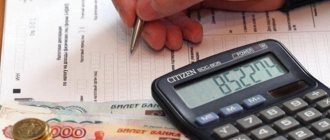Any organizations or entrepreneurs that pay wages and other remuneration to individuals are tax agents.
When paying employees salaries, the tax agent is obliged to calculate the amount of tax, withhold it and transfer it to the budget. According to paragraph 4 of Art. 226 of the Tax Code of the Russian Federation, income tax, that is, personal income tax, is withheld from the income of employees upon their actual payment. But at the time of payment of the advance, this tax is not paid.
The income of an individual for calculating income tax can be expressed in any form: monetary, tangible and intangible.
How to calculate salary income tax in 2021?
Salary income tax is calculated as follows:
- All income received by an employee is summed up: incentives, bonuses and other additional payments are taken into account.
- Official expenses are deducted from the total amount - tax deductions (standard, property and social).
- The amount received is subject to tax of 13%, 15% or 30%.
The interest rate for personal income tax in 2021 depends on the status of the taxpayer: (whether he is a resident of the Russian Federation or not), and on the amount of income.
First, let’s find out who is a resident of the Russian Federation. Officially, a taxpayer is a resident of the Russian Federation if he stays in our country legally for more than 183 calendar days. Moreover, during these 183 days the person does not leave the Russian Federation. Otherwise, the taxpayer receives non-resident status.
In general, personal income tax rates for residents are 13%, and for non-residents – 30%.
Please note that your employee's tax status for personal income tax purposes may change throughout the year. Therefore, at the end of the year it is necessary to recalculate personal income tax at the appropriate rate.
2021 will see a change that has been talked about for a long time.
Federal Law No. 372-FZ dated November 23, 2020 introduced a progressive scale of personal income tax rates from January 1, 2021.
The progressive scale of tax rates is the same for residents and non-residents:
13 percent – from the amount of income within 5 million rubles for the tax period (year); 15 percent - from the amount of income over 5 million rubles for the tax period (year).
Before calculating salary income tax (personal income tax), you first need to take into account the tax deduction. According to the legislation of the Russian Federation, a tax deduction is a benefit that is provided to employees.
Tax deductions are usually:
- 500 rubles;
- 1,400 rubles;
- 3,000 rubles.
Here's an example:
A woman’s monthly income is 12,000 rubles. She is the mother of a minor child. According to the law, a tax deduction of 1,400 rubles is provided for this category of citizens of the Russian Federation. In this case, income tax on wages will be calculated as follows: 12,000 - 1,400 = 10,600 rubles.
Salary calculation example
Zhdanov A.G. works as a sales manager. This is the main place of work, deductions are provided here. His salary is set at 25,000 rubles. At the end of the month, if he fulfills the sales plan, he is awarded a bonus in the amount of 25% of his salary. The employee has two children.
There are 20 working days in a billing month, 9 of which are for the advance part, 11 days for the main part.
We will calculate the advance payment. Since the bonus is paid based on the results of the month, it does not take part in determining it.
The advance amount will be: 25,000 / 20 x 9 = 11,250 rubles.
Taxes are not withheld from the advance payment, so this amount must be issued in person.
The sales plan was fulfilled. The monthly salary was: 25,000 x 1.25 = 31,250 rubles.
Amount of tax to be withheld (tax deduction for children is taken into account): (31250 - 1400 - 1400) x 13% = 3699 rubles.
The remaining part of the salary for payment (adjusted to the previously issued advance): 31250 - 3699 - 11250 = 16301 rubles.
Salary income tax percentage rates in 2021
It should be noted that the interest rates of income tax are directly dependent on such a factor as the status of the taxpayer (taking into account the types of income he received).
Tax payers in the Russian Federation are divided into two types:
- Tax residents are people who arrived in the Russian Federation and stayed on its territory for at least 183 days (over the last year).
- Tax non-residents are citizens of foreign countries who have been on the territory of the Russian Federation for less than 183 calendar days over the last year (12 calendar months).
The vast majority of Russian citizens are tax residents. Income tax on residents' salaries is 13%.
Also, a personal income tax rate of 13% is provided for EAEU citizens who work in Russia. The countries that are members of the EAEU include Belarus, Kyrgyzstan, Kazakhstan, and Armenia.
And another category of the population with a personal income tax rate of 13% is refugees and immigrants.
Please note that a citizen of the Russian Federation can simultaneously be a non-resident of the Russian Federation, while a foreigner, on the contrary, has the rights of a resident. This depends on the number of days spent on the territory of the Russian Federation (letter of the Federal Tax Service dated September 19, 2016 No. OA-3-17 / [email protected] ). Status is determined on the date of receipt of income. For example, if an employee was accrued income on March 20, it is necessary to calculate how many days this employee was in the Russian Federation from March 21 of the previous year to March 20, the year the income was accrued.
Attention, this calculation procedure applies to income received by an individual through a tax agent - the employer pays the employee. If we are talking about the need for the taxpayer to pay the tax on his own, then the status is calculated based on the full calendar year for which the 3-NDFL tax return is filed.
For non-residents of the Russian Federation, income tax on wages is calculated at a rate of 30%.
If a non-resident stays on the territory of the Russian Federation for more than 183 calendar days, then the income tax on his salary will in this case be not 30%, but 13%.
CHANGE IN THE DEFINITION OF RESIDENCE IN 2021
Federal Law No. 265-FZ of July 31, 2020, reduced the personal income tax rate by almost three times for some employees. Moreover, the reduction will occur for the entire 2021 retroactively.
According to the above Law, an employee who was actually in the Russian Federation from 90 to 182 calendar days in 2021, and not 183 days or more, can be recognized as a tax resident of the Russian Federation.
Moreover, in order to become a resident of the Russian Federation under new conditions, the employee had to submit a free-form application to the Federal Tax Service by April 30, 2021 and receive an overpayment from the budget.
After the law came into force, accountants now calculate taxes according to the new rules.
Personal income tax rates for residents and non-residents
Two personal income tax rate options are applicable to an employee’s salary:
- 13% for residents of the Russian Federation;
- 30% for non-residents.
There is a widespread belief that all foreigners are non-residents of Russia, while having a Russian passport automatically means tax resident status. This is a deep misconception.
When determining resident status, it is not citizenship that matters, but the period during the year spent by the taxpayer in the territory of the Russian Federation. If this period is from 183 calendar days per year, not counting short-term trips for recreation or treatment, the person is a resident, regardless of what citizenship he has or whether he has any at all.
If a Russian citizen lives permanently in the Russian Federation and travels abroad only on vacation and business trips, he is a resident. But if he lives permanently abroad, visiting Russia only on short visits and spending less than the mentioned 183 days a year in the country, he is a non-resident and from his income from Russian sources, be it income from rental property, salary from hired work, if he has an employment relationship with the Russian employer and performs his official duties remotely, which is now widespread, he is a non-resident. And the personal income tax rate on such income in his case is 30, not 13%.
If a foreigner spent 183 days in Russia in a calendar year, he is considered a resident and pays personal income tax at a rate of 13%
The same arithmetic applies to foreigners and stateless persons.
The company employs a programmer who is a citizen of Russia but permanently lives in Thailand, and a driver who has citizenship of Uzbekistan and a residence permit in the Russian Federation and spends more than 183 days a year in the country. In this case, the programmer is a non-resident, and the driver is a resident, which is accordingly reflected in the taxation of their income.
In practice, the following approach is applied to foreigners and stateless persons: during the first six months of residence in the Russian Federation, personal income tax is withheld from their salaries at a rate of 30%. Then the overpaid personal income tax is returned (that is, 17% of each salary for these six months), and income is taxed at a rate of 13%.
There are also categories of foreigners from whose salaries personal income tax is withheld at a rate of 13%, regardless of resident status. These include:
- working in the Russian Federation under a patent;
- recognized as highly qualified specialists and on this basis received permission for a long stay in the Russian Federation;
- citizens of the Republic of Belarus, Kazakhstan and Armenia - on the basis of agreements within the EAEU.
For highly qualified foreign specialists, personal income tax is withheld at a rate of 13%
Standard, social and property deductions
In some cases, to reduce personal income tax, you can use standard, social and property deductions provided for by the legislation of the Russian Federation.
Standard deductions are provided to the following categories of citizens:
- parents (adoptive parents or guardians) who have dependent minor children;
- parents who have dependent students under 24 years of age.
The benefit amount is 1,400 rubles (for each first and second child). If there are three or more children in a family, then a deduction of 3,000 rubles is provided for the third and each subsequent child. You can use the standard deduction only at your main place of employment. Moreover, both parents have the right to claim this deduction.
Another option for receiving a deduction is that the deduction can be provided in double amount at the place of work of one of the parents, if the other parent has submitted an application for not receiving a deduction at his place of work.
For guardians, trustees and their spouses raising a disabled child under the age of 18, or a disabled child of groups 1-2 studying full-time at an educational institution under the age of 24, the amount of deduction for such a child is 6,000 rubles.
For parents and adoptive parents of a disabled child until he reaches 18 years of age, or if such a child is disabled in groups 1 or 2 and is studying full-time, then until he reaches 24 years of age, the deduction amount is 12,000 rubles.
The personal income tax deduction is provided to the employee from the beginning of the calendar year, even if the application was submitted later.
If during the year the employee has not used the right to deduction, he can receive monetary compensation from the Federal Tax Service by submitting to the Federal Tax Service an income declaration and certificates confirming the right to deduct.
The right to a deduction in the amount of 1,400 rubles is lost if the amount of total income (during the reporting year) is more than 350 thousand rubles.
Social deductions are provided:
- for education (your own or your children’s);
- for treatment;
- for the purchase of medicines;
- for pension provision.
Property deductions are provided in the following cases:
- car sales;
- sale (purchase) of real estate (real estate share) or land.
The property deduction can only be used once (for example, when paying mortgage interest).
A complete list of benefits and deductions available to citizens of the Russian Federation is contained in Article 218 of the Tax Code of the Russian Federation.
Where and when should insurance premiums be paid?
An individual entrepreneur pays insurance contributions to the tax office at the place of registration. The fixed payment must be transferred by December 31 of the current year, that is, contributions for 2021 are due by December 31, 2021. Accruals from income totaling more than 300,000 rubles are transferred to the Federal Tax Service until July 1 of the following year.
If an entrepreneur ceases his activities in the middle of the calendar year, then 15 days are allotted to pay contributions.
Income tax on minimum wage in 2021
Income tax on the minimum wage is calculated in the same way as on other types of employee income. The employee has the right to use his tax deductions. When a taxpayer is eligible for more than one standard tax deduction, he or she may only take one.
You cannot add up multiple standard deductions, with the exception of child deductions.
Income tax calculated at the rate (13% or 30%) is withheld from the employee’s minimum wage. The employee receives a salary minus personal income tax.
The minimum wage income tax calculated at the appropriate rate is withheld from the employee’s income. The employee is paid a salary minus personal income tax. Other deductions (loan repayment, alimony, etc.) are deducted from the amount remaining after deducting personal income tax.
Income that is not subject to taxation
List of income that is not taxed by law (Article 217 of the Tax Code of the Russian Federation):
- scholarships;
- all types of social benefits and pensions;
- maternity benefits;
- unemployment benefits;
- alimony (based on court decisions);
- financial assistance up to 4,000 rubles (per year);
- various types of compensation (travel and daily allowances).
Personal income tax is levied in accordance with the general procedure on payments for sick leave for temporary disability (or for caring for a patient).
Maximum deductions may be taken into account when calculating payroll income taxes when an employee falls under multiple deduction categories.
In the case of vacation (illness), income tax on wages in 2020 is calculated based on the average salary.
Salary income tax is withheld from employees who entered into contract agreements.
Advance and salary – on what part are taxes levied?
Advance and salary are two parts of the employee’s income, which he receives for his activities at the end of the month. The advance must be issued based on the results of the first 15 days of work, and the rest is payment for the second half of the month, and it is issued before the 15th day of the month following it. When issuing the final part, the organization settles with the employee, and at the same time the tax is withheld.
The law states that the date of receipt of income for employees is considered to be the final day of the month. Since the advance is usually paid before this date, there is no need to withhold taxes on it. The amount of personal income tax subject to withholding is determined when calculating wages and is withheld from the employee at the time the second part of the salary is issued. The next day after this, the tax must be sent to the budget.
There is an exception to this rule. If the decision to issue an advance is made on the last day of the month, and according to the law, the employee receives income on the same day, then tax must be withheld and transferred from the amount paid. This position is also taken by the court in disputes between companies and the Federal Tax Service.
You might be interested in:
Payroll form T-49: when used, sample filling, main errors, postings
Attention! The amounts of contributions to the funds are calculated at the time the salary is calculated for its entire amount, and are transferred until the 15th day of the next month. Therefore, the date of payment of the advance does not affect them in any way.
Calculation of income tax in 2021 with example
Income tax calculation for 2021 is as follows:
1. All employee income is summed up, including bonuses, incentives, and additional payments. 2. The amount of the deduction is determined. 3. Deductions are deducted from the entire amount of income. 4. The interest rate of income tax is determined depending on the status of the employee: resident 13% or non-resident 30%. 5. The amount of tax payable to the federal budget is calculated.
Example 1:
It is necessary to calculate the personal income tax for the month of work of a resident of the Russian Federation with 3 children.
The employee's monthly income was 75,000 rubles.
The deduction for three children will be 1400 + 1400 + 3000 = 5800 rubles.
Personal income tax for such an employee will be:
(75,000 – 5800) X 13% = 8,996 rubles.
For this employee, the possibility of applying the tax deduction for children will end when his total income reaches 350,000 rubles.
Example 2:
Let's look at how to calculate personal income tax at a rate of 15%, introduced on January 1, 2020, for high wages.
The director of ION LLC receives a salary of 500,000 rubles per month. As of October 2021, the director has been paid 5 million rubles since the beginning of the year. Personal income tax on income for January-October 2021 amounted to 650,000 rubles. (10 months x RUB 500,000 x 13%). At the same time, the tax rate on this income was used in the amount of 13%. Starting from November 2021, a personal income tax rate of 15% will be applied to tax the director’s income. Consequently, during these last two months of 2021, 150,000 rubles were paid to the budget. (2 months x RUB 500,000 x 13%).
Many personal income tax payers believe that they can receive a tax deduction in the form of monetary amounts. This is completely false. In reality, the income received is reduced by the amount of the tax deduction, and then the personal income tax payable is calculated.
If there are no changes in 2021, which we will discuss below, then the example of calculating income tax described above in the text will be relevant in 2021.
Insurance
As for insurance payments, they are divided into four categories:
- pensions,
- medical,
- social,
- from accidents.
As before, control over the payment of insurance is entrusted to the tax authorities. Accident insurance is covered by the social insurance system.
When paying this “four”, legislators determined a threshold - the total amount of payments should not exceed 30% of the salary.
The general scheme of insurance payments is as follows:
| Base rate | Limit amount (RUB) | Bid over limit amount (%) | |
| Russian Pension Fund | 22 | 876000 | 10 |
| Social Insurance Fund | 2,9 | 755000 | 0 |
| Compulsory Medical Insurance Fund | 5,1 | Not installed | 5,1 |
| Accident Protection Fund | 0.2-8.5, based on the type of activity | Not installed | 0.2-8.5, based on the type of activity |
Please pay attention to the established payment limits. For the Pension Fund, this results in a limit of 3 million 981 thousand 818 rubles. This is another 22%, more - already 10%.
Planned changes in the calculation of income tax in 2021
Let us immediately note that the expected changes in the calculation of income tax in 2021 are not very joyful.
Independent experts from RANEPA carried out calculations and came to the conclusion that if the personal income tax is increased, it will be possible to balance the Russian budget. What prompted them to make such calculations - guess for yourself.
The Ministry of Finance did not ignore the experts’ conclusions and prepared a bill. The essence of this bill is to gradually increase income tax from 2021 to 2025 by 1% annually for five years:
- 2021 – 1%;
- 2022 – 2%;
- 2023 – 3%;
- 2024 – 4%;
- 2025 – 5%.
As a result, by 2025, personal income tax will increase by 5% compared to 2021, and it will be necessary to withhold from employees not 13%, but 18%. An additional percentage of personal income tax will be used to form pension capital.
The bill also suggests that employees will have the right to refuse to withhold additional funds by providing the employer with a corresponding application. For now, increasing personal income tax is only in plans, but whether they are implemented or not, time will tell.
The material has been edited in accordance with changes in the legislation of the Russian Federation 01/18/20202
How to calculate the size of the tax base?
It is important to note: before making calculations, you need to correctly calculate the tax base, and also make sure that the employee’s total annual income does not exceed the limit established by law.
To do this, you need to multiply the established salary by the serial number of the month for which the calculations are made. For example, in December the conditional 10 thousand rubles will need to be multiplied by twelve. The result will be 120 thousand rubles. This means that the set limit has not been exceeded.
If an employee's income differs from month to month, the employee's task becomes somewhat more difficult. After all, it will not be enough for him to simply multiply two indicators. You will have to add up the wages accrued for each month to make sure you meet the limit.
As for the tax base, it must include all payments under an employment or civil contract. The peculiarity of the latter is that they do not require the calculation of social contributions. In fact, the tax base depends on the level of remuneration set by the employer. The reality is that many companies try to lower the level of payment in order to reduce the number of tax deductions to various funds.
This might also be useful:
- What taxes does the individual entrepreneur pay?
- simplified tax system for individual entrepreneurs in 2021
- Tax system: what to choose?
- Individual entrepreneur insurance premiums for employees in 2021
- Individual entrepreneur reporting on the simplified tax system without employees
- How much taxes does an individual entrepreneur pay in 2021?
Is the information useful? Tell your friends and colleagues
Dear readers! The materials on the TBis.ru website are devoted to typical ways to resolve tax and legal issues, but each case is unique.
If you want to find out how to solve your specific issue, please contact the online consultant form. It's fast and free!
Employer reporting
The employer’s responsibility is to compile and submit to government agencies a whole package of reports, the data for which is the amount of accrued wages.
- 2-NDFL - at the end of the year, a separate form is issued for each employee, which includes data on accrued wages, deductions, withheld and transferred tax.
- 6-NDFL - issued every quarter. Includes two sections - the first indicates the amounts of wages and taxes from the beginning of the year, the second - in the context of the reporting quarter;
- A unified calculation of insurance premiums is a form that was introduced in 2021 instead of RSV-1. Rented every quarter for all company employees;
- 4-FSS - sent to social insurance every quarter, contains information on the calculation and payment of employer contributions for injuries;
- SZV-M - compiled for all employees of the company every month. Its main goal is to control pensioners who continue to work and at the same time receive a labor pension.
- SZV-STAZH is a new report, which began to be submitted for the first time in 2021. Contains data on the length of service of all employees over the past year, including contract agreements.
Comments
View all Next »
Dimon 07/02/2015 at 22:55 # Reply
Thank you! Your article helped me!
Salavdin 03/05/2016 at 10:13 am # Reply
Is income tax withheld if the salary does not exceed 2,500 rubles?
Natalia 03/05/2016 at 01:27 pm # Reply
Salavdin, good afternoon. In the Russian Federation there is no minimum limit for personal income tax; personal income tax must be withheld from income of any amount. You also have the right to claim tax deductions - standard, social, property. If you have reasons for this. STANDARD BENEFITS: From 1000 rubles per child, 13% is not charged monthly, the remaining amount is taxed as standard; SOCIAL BENEFITS: From 2000 rubles onwards, single parents are not subject to 13% personal income tax per month; For military personnel in the Afghan war, 13% is not taken from 500 rubles monthly; Parents of a disabled child are not charged 13% monthly on 2,000 rubles. PROPERTY BENEFITS: You can reduce the amount of personal income tax when buying or building your own house (apartment).
Olga 03/16/2016 at 07:59 pm # Reply
I am a mother of 3 minor children. How much is the tax deduction in my case? Thank you)
Natalia 03/16/2016 at 20:34 # Reply
Olga, hello. The deduction for children is valid until the month in which your income from the beginning of the tax period (year) exceeded 350,000 rubles. In 2021, the deduction for the first child will be 1,400 rubles; For the second child – 1400 rubles; The deduction for the third child is 3,000 rubles. It is necessary to understand that the deduction is not an amount that you can return, but an amount on which 13% tax is not withheld. For you, the amount of benefits will be (1400 + 1400 + 3000) * 0.13 = 754 rubles monthly. Your husband can also receive a deduction in the same amount if he has taxable income.
Ella 03/28/2016 at 12:47 pm # Reply
Good afternoon Help me find out how much tax my employer should deduct from me. I work in a hairdressing salon, I am registered as a half-time employee with a minimum wage, I have a child (3 years old) Thank you!
Natalia 03/29/2016 at 08:59 # Reply
Good afternoon, Ella. The employer is required to withhold and transfer 13% of your monthly income to the budget. There is a standard deduction, i.e. reduction of personal income tax. For the first child, the tax deduction is 1,400 rubles. Those. this amount is not subject to personal income tax. Considering that your earnings are half the minimum wage: 6204/2 - 1400=2402 x 13%=312.26. Therefore, the employer must deduct 312.26 rubles from your salary, and you should receive 2,789.74 rubles in your hands. This calculation is made assuming that you receive 50% of the minimum wage. There is also a condition under which an employer can apply a child tax deduction: you must submit an application in which you must state your desire to receive a child tax deduction and attach to it copies of documents confirming your right to receive a child tax deduction. If you have not submitted such an application to your employer, then he does not have the right to reduce your personal income tax, but is obliged to calculate and transfer 13% of your income to the budget.
Ella 03/30/2016 at 10:03 am # Reply
Thanks a lot!
Tatyana 04/02/2016 at 09:08 # Reply
Hello. Please help me calculate my income tax. My husband has a salary of 7,500, income tax is 2,000 rubles. But we have 2 minor children. Is it correct to deduct from him?
Natalia 05/13/2016 at 11:49 am # Reply
Tatyana, good afternoon. Income tax on income is 13%. That is, even without standard deductions for children, income tax on an income of 7,500 rubles will be 975 rubles. He probably has an income of more than 7500-00. If your husband writes an application for a tax deduction for two children, the employer will be required to apply a deduction at the rate of 1,400 rubles for each child. Those. (7500-2800)x 13%= 611-00. That is, the income tax will not be 975, 611 rubles. Your husband may not submit such an application to the employer, but simply submit an application to the Federal Tax Service at the end of the year and have the amount of the standard tax deduction for children returned to him.
Albina 04/08/2016 at 14:51 # Reply
Hello. This is a question, I have two children, with the eldest child I am a single mother. She got married, but her husband did not adopt the child. Now the accounting department says that I am not entitled to the single mother benefit for the eldest, because... I got married. Only a benefit for two children, although according to another organization they also kept it as a single child. I provided them with a certificate from the registry office. Thanks.. Are they right?
Natalia 05/13/2016 at 11:56 am # Reply
Albina, good afternoon. If you have a dash in the father column on your child’s birth certificate and your second husband did not adopt the child, then you retain the status of a single mother.
Alexander 05/11/2016 at 20:55 # Reply
Hello, my wife and I work at the same municipal enterprise, but we were denied deductions for children, since we are not citizens of the Russian Federation. We are refugees from Donbass, we have 5 minor children, two of them are adopted, orphans. Is it legal for us They refused, because refugees, by law, enjoy all the rights that non-citizens of the Russian Federation have. Please tell me. Thank you.
Alexander 05/11/2016 at 20:55 # Reply
Hello, my wife and I work at the same municipal enterprise, but we were denied deductions for children, since we are not citizens of the Russian Federation. We are refugees from Donbass, we have 5 minor children, two of them are adopted, orphans. Is it legal for us They refused, because refugees, by law, enjoy all the rights that non-citizens of the Russian Federation have. Please tell me. Thank you.
Natalia 05/13/2016 at 12:05 # Reply
Alexander, good afternoon. Since a foreign citizen or stateless person who is recognized as a refugee or has received temporary asylum on the territory of the Russian Federation in accordance with the Federal Law “On Refugees” is not a tax resident of the Russian Federation, deductions are not provided to him. To be eligible for deductions, you must become a tax resident of the Russian Federation. If your stay in the Russian Federation is more than 183 days, you have the right to obtain resident status.
Svetlana 05/12/2016 at 01:41 pm # Reply
Hello, I have a child in my care, how much should the tax be taken from? Thank you
Natalia 05/13/2016 at 12:11 # Reply
Svetlana, according to paragraph 4, paragraph 1 of Art. 218 of the Tax Code of the Russian Federation, a tax deduction is provided in double amount to the only parent (adoptive parent), adoptive parent, guardian, trustee. If you are not the only parent, then the deduction is provided in a standard amount - depending on the number of children, it does not matter whether they are your children or those under guardianship. If you have one child, then the deduction is 1400 rubles, if you have two, then 2800 rubles, if you have three, then 2800+3000=5800 rubles.
View all Next »
Insurance premiums
For employee benefits, you must accrue and transfer to the Federal Tax Service insurance contributions for pension, medical and social insurance. And in addition to this, payments to the Social Insurance Fund for accident insurance. And unlike personal income tax, you make these deductions out of your own pocket, and do not deduct them from your salary.
Attention! If the employee is hired under an employment contract, then you must transfer all these contributions, and if under a civil law contract for the provision of services, then only pension and medical payments are required for you. Accident insurance and social insurance are not required under such agreements, but you can make such payments of your own free will by stipulating this in the GPC agreement.
It is impossible not to insure employees. It is illegal to shift this responsibility to employees and to stipulate this in the employment contract.
In the “My Business” service you can fill out the RSV form yourself and submit it to the tax office
The software we have developed will help you avoid errors in reporting.
Try for free
Classification of deductions
There are several types of benefits used in the Russian Federation. Their terms and conditions are specified in the relevant articles of the Tax Code of the Russian Federation.
Table 1. Regulatory framework
| View | Article of the Tax Code of the Russian Federation |
| Property | 220 |
| Standard | 218 |
| Social | 219 |
| Investment | 219.1 |
| Professional | 221 |
Property
Due to transactions carried out by a citizen with property:
- its sale;
- acquisition of living space or a share in it;
- construction of housing or purchase of a plot of land for this purpose;
- acquisition of property from a taxpayer for government needs;
- the cost of repair work if the housing is taken with a rough finish.
The maximum return amount per year is measured by the personal income tax transferred for the year. Then the balance is carried over to the next year and so on until the limit determined by the state is exhausted. In this case, it is allowed to take a deduction at any time, but only funds for the previous 3 years are subject to reimbursement.
IMPORTANT! Non-working people who have recently retired and bought housing can also take advantage of the benefit. They receive a refund for the previous period (3 years previous to the transaction), when they carried out work activities and tax deductions. Employed pensioners can additionally receive benefits further if the maximum deduction amount is not reached during the payment period.
Conditions for assigning a personal income tax refund:
- To qualify for the exemption, the property must be residential. Its location in Russia is a must. If the purchased non-residential premises are converted into residential premises, the deduction will be denied.
- The maximum benefit value is defined as 13% of 2 million rubles (260 thousand). Returns are only possible once in a lifetime. However, if there is a shortfall, it is allowed to use the balance in the future on the next purchase of property. For example, if a citizen purchased living space for 1.7 million rubles, he is entitled to a deduction of 221 thousand rubles. Since the limit has not been spent, he can use the remainder (39 thousand rubles) in the future.
- The limit when registering premises under a loan agreement is 13% of 3 million rubles (390 thousand rubles). Such personal income tax compensation for interest on targeted loans for the purchase of property can be used only once and for one object. If the mortgage interest cap is not used up, the balance is forfeited.
- Maternity capital is not refundable. For example, living space was purchased for 2 million rubles, but part of it was paid for by maternal capital in the amount of 400 thousand rubles. In this case, the deduction is assigned from 1.6 million rubles.
- The benefit is not provided if the property was acquired at the expense of the state, employer, or purchased from relatives, subordinates and other interdependent citizens (Article 105.1 of the Tax Code of the Russian Federation).
The use of a property deduction is advisable not only when purchasing, but also when selling property. The limit for housing is 1 million rubles, for non-residential areas, cars, garages - 250 thousand. If a person sells property that is in his possession for less than a certain period of time, he is obliged to pay 13% of the income.
IMPORTANT! According to innovations in legislation, from May 1, 2018, the period of minimum ownership of residential space has been increased to 5 years. However, for property purchased before 2021, or as a result of a gift, under a maintenance agreement with a dependent, recently privatized, the period remained the same (3 years).
No personal income tax is collected on residential space worth less than 1 million rubles
When transferring 13% of sales, you can take advantage of a fixed deduction, reducing the taxable portion. For example, in 2021, a citizen sold a premises purchased in 2021 for 1.5 million. Since the ownership period has not passed (5 years), he must transfer 13% of the income or 195 thousand rubles to the state. If you use the deduction, you can reduce the amount by 1 million, that is, the tax will be: (1.5 million-1 million) * 13% = 50.7 thousand rubles.
Video - Property deduction in 2021
Standard
The benefit allows you to reduce the amount of tax on a monthly basis. It is mainly appointed through the employer, but personal application to the Federal Tax Service is also acceptable.
Table 2. Standard tax deductions
| Reason for granting the benefit | Amount, rub. | Peculiarities |
| Event participants | ||
| “Chernobyl survivors”, liquidators of man-made accidents, disabled people of war and WWII | 3000 | If there are conditions for assigning 2 payments, choose the most beneficial option for the citizen |
| Heroes of the Russian Federation, USSR, participants in wars, WWII, disabled people of groups 1 and 2, childhood (Article 218 clause 2 of the Tax Code) | 500 | |
| For a child under 18 years old | ||
| On the 1st and 2nd | 1400 | Paid monthly until the amount reaches 350 thousand rubles. The amount of the benefit is doubled for a parent who is raising a child alone or if the other has refused it |
| On the 3rd and onwards | 3000 | |
| For a child with a disability up to 18 years old, for a student, graduate student, intern, and so on up to 24 years old with a disability of 1st and 2nd groups | 12,000 for parents, 6,000 for guardians | |
For example, a citizen is raising a 10-year-old daughter alone. A woman’s salary is 50 thousand rubles. She is due a double deduction for 1 child. She filed an application for her intention to take the benefit in January. The deduction will reach the maximum amount (350 thousand) in 7 months, that is, from January to July, the benefit is deducted from her income and only after that the tax is calculated. The savings during this time on personal income tax payments for a woman will be: (1400*7 months*0.13)*2=2548 rubles.
Video - Standard deduction for children
Social
The benefit is primarily aimed at partial reimbursement of costs for education and medical treatment, as well as for the formation of a future pension and charity. The maximum amount of all social deductions is 120 thousand rubles. Due to personal income tax reimbursement, compensation for medical care is provided:
- Own treatment of the child or parents, including in a clinic, inpatient settings, paid institutions.
- Stay at health resorts. The benefit is provided only for expenses of one’s own funds, and not of state or trade union ones.
- Dental services: treatment and prosthetics (non-cosmetic).
- Spending on drugs.
- Costs of voluntary health insurance (if the policy is paid for by the employee and not by the employer).
IMPORTANT! To issue a refund, the medical institution must be located in the Russian Federation and have a state license. It is necessary to keep the contract for the provision of services and confirmation of payment. Medicines are indicated on form 107/у.
Form 107-1/у
The peculiarity of the deduction for medical treatment is the possibility of receiving benefits without a limit on its value. This applies to some expensive drugs and treatments. Their list is presented in Decree of the Government of the Russian Federation No. 201 of March 19, 2001.
Section 1. Anesthetics and muscle relaxants (RF Government Decree No. 201)
For example, a citizen underwent surgery for 1 million rubles. If the operation is indicated in the list defined by law, this amount is deducted from the person’s income, and personal income tax is payable on the balance. But if a negative result is obtained, when cash receipts are lower than the costs of treatment, the citizen is required to return all tax withheld for the period.
Social deductions also include tuition reimbursement:
- Own - any education is taken into account, including distance education, correspondence or abroad. But the establishment must provide a license for its activities.
- Your own or a sponsored child under 24 years of age. Only full-time education is allowed.
- Brother or sister under 24 years of age. Also, only full-time studies are taken into account.
The benefit does not include the education of spouses, uncles, aunts and other relatives. The maximum amount of return for your studies, a brother or sister is 120 thousand, for your own or a child under your care - 50 thousand rubles.
A deduction for financing a future pension is assigned to citizens making contributions:
- in NPF;
- to insurance institutions (life insurance for a period of over 5 years, pension).
At the same time, it is possible to form your own pension contributions for your spouse, parents, or disabled child.
Citizens who make donations to charitable institutions and non-profit organizations have the right to take a deduction for charity.
IMPORTANT! The benefit is not assigned above 25% of a person’s income for the year.
For example, a citizen transferred 200 thousand rubles to charity. For the year, a person’s income was 400 thousand. The benefit cannot be more than 400 thousand * 25% = 100 thousand rubles. Refund amount = 100 thousand * 13% = 13 thousand rubles. The deduction is not assigned if:
- contributions not to charitable institutions, but to funds organized by them;
- assistance with goods and services, rather than cash (provision of premises, advertising, etc.);
- transfers to individuals.
Professional
This type of deduction is considered separate because it is primarily provided to entrepreneurs. Acting as an individual and making deductions from cash receipts, he has the right to use the benefit. The following may qualify for a professional return:
- Individual entrepreneurs staying under the general taxation regime (OSNO);
- practicing notaries, lawyers, etc.;
- taxpayers registered under civil law contracts;
- citizens receiving rewards in the field of art, culture, science;
- self-employed citizens (since 2021, a pilot project has been operating in 4 regions of our country).
Refunds are made for the full amount of costs confirmed by relevant documentation (payments, contracts).
IMPORTANT! Sometimes, if it is impossible to demonstrate expenses for individual entrepreneurs, the deduction rate is set at 20% of income. Self-employed citizens have their own deduction: they do not pay tax until the amount of the calculated fee is 10 thousand rubles.
For some types of remuneration, the legislation defines cost standards.
Costs for various types of activities (clause 3 of Article 221 of the Tax Code of the Russian Federation)
Investment
This type of return is assigned:
- For proceeds from the sale of securities, if a citizen has owned them for more than 3 years. The benefit does not apply to transactions made on an IIS (individual investment account).
- From income contributed over 3 years to IIS. The limit is 400 thousand rubles, that is, 13% of this amount (52 thousand rubles) is allowed to be reimbursed per year. The benefit is intended for people who are employed and have a “white” salary.
- From proceeds from trading in securities carried out on an individual investment account for 3 years. The peculiarity of the benefit is that it can be used by self-employed, unemployed people without reference to salary.
Results
Income received by both employees and self-employed persons is subject to personal income tax and insurance contributions.
For most employers, generally established rates apply, but a number of them have the right to take advantage of their reduced values when calculating insurance premiums. The amount of payments is influenced by the annual change in the minimum wage and the amount of income, upon reaching which the accrual of contributions stops (FSS) or the value of the applied rate (PFR) changes. You can find more complete information on the topic in ConsultantPlus. Free trial access to the system for 2 days.
Features of calculation and accrual of payroll taxes
Depending on the enterprise and the employment contract, there are various forms of remuneration. According to labor law, salaries are paid at least twice a month, but taxes and contributions to funds are made only once.
Thus, taxes and fees to funds are not charged on the advance payment, but are calculated directly on wages at the end of the month, taking into account all sick leave, vacation and advance payments.
The difference between accrued wages and the actual wages received by the employee may contain additional types of deductions, which, in turn, should not exceed 20% in total.
Payroll calculation and timely deduction of taxes to the Pension and Insurance Funds is a rather labor-intensive process that requires careful consideration of all items of tax deductions.
Providing inaccurate or incorrect employee salary information may be considered a violation and subject to a fine.
Who are you from the point of view of tax authorities?
The tax base for income contributions is divided into several types of payers, which determines the interest rate.
- Residents of the Russian Federation . This is the vast majority of hired workers: those people who have been in the country for at least 183 calendar days over the past year. The accounting of time of stay is not affected by business trips, trips abroad for treatment or training, if the period of stay abroad does not exceed 6 months. Citizenship does not matter for residency status. The interest rate of income tax for a resident is 13%.
- Non-residents of the Russian Federation - respectively, other persons whose absence within the borders of the Russian Federation during the year exceeds the established 183 days.
- Founders or shareholders of the enterprise . For business owners, the tax rate is calculated based on 9%.
- Contributors and winners . People who benefit from income from bank deposits, as well as those lucky enough to receive prizes or winnings, are also required to share their joy of income with the government in the amount of 35%.
REFERENCE! Since in this article we are considering the relationship between employer and employees, resident/non-resident status matters for calculating income tax.








